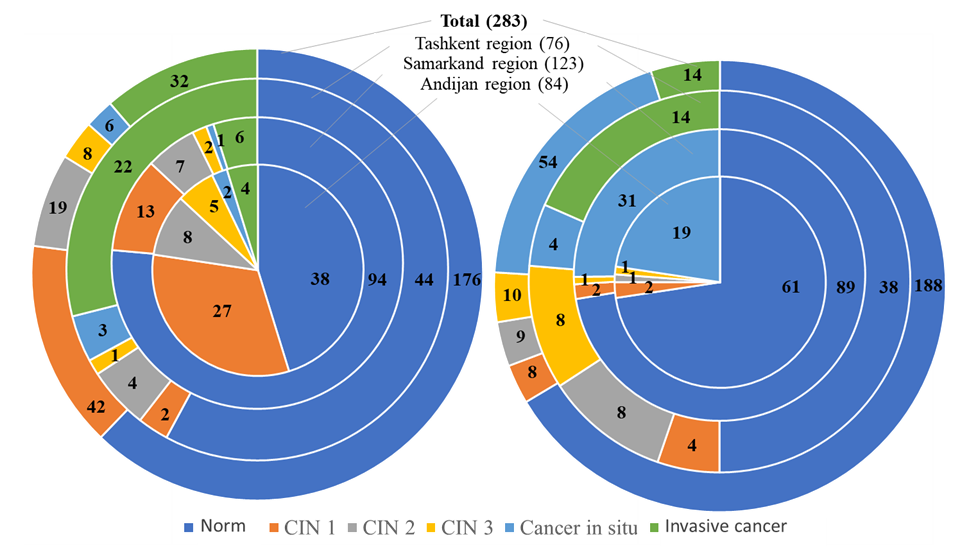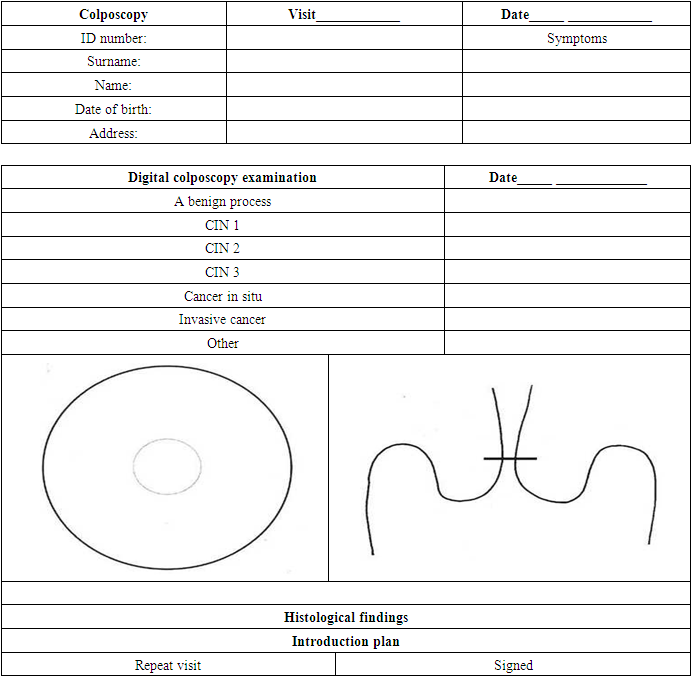-
Paper Information
- Next Paper
- Previous Paper
- Paper Submission
-
Journal Information
- About This Journal
- Editorial Board
- Current Issue
- Archive
- Author Guidelines
- Contact Us
American Journal of Medicine and Medical Sciences
p-ISSN: 2165-901X e-ISSN: 2165-9036
2023; 13(8): 1134-1137
doi:10.5923/j.ajmms.20231308.21
Received: Aug. 10, 2023; Accepted: Aug. 26, 2023; Published: Aug. 28, 2023

Diagnostics of Precancerous Diseases of the Cervix by Colposcopy Based on Artificial Intelligence in the Republic of Uzbekistan
N. N. Zakhirova, M. N. Tillyashaykhov, D. A. Nishanov, V. A. Saidakhmedova, S. Janklich, E. Z. Osmanova, M. M. Otajanov
Republican Specialized Scientific and Practical Medical Center of Oncology and Radiology, Tashkent, Uzbekistan
Copyright © 2023 The Author(s). Published by Scientific & Academic Publishing.
This work is licensed under the Creative Commons Attribution International License (CC BY).
http://creativecommons.org/licenses/by/4.0/

Cervical cancer mainly occurs in women aged 35 to 55 years, rarely at the age below 20 years and only in 20 percent of cases after 65 years. According to statistics, 90 percent of mortality from cervical cancer occurs in low-income developing countries, where methods of early diagnosis and treatment of this type of cancer are not sufficiently implemented and applied. Uzbekistan is one of six pilot countries within the framework of the Joint UN Global Program for the Prevention and Control of Cervical Cancer. The program aims to join forces to work with the Government and other partners to promote the development and implementation of a sustainable, comprehensive and high-quality national cervical cancer program that provides women with equal access to services and information. The aim of the study is to conduct in-depth research on the early detection of precancerous diseases with the help of modern methods using artificial intelligence AIDOT. The study included 283 women. The age of the patients varied from 28 to 54 years (mean age was 42.6±3.2 years). Colposcopy was performed using artificial intelligence AIDOT in accordance with the requirements of the developers. The introduction of artificial intelligence-based colposcopy methods in Uzbekistan will allow to expand the scope and coverage of gynecological examination of the low-income population, to obtain rapid examination results as an alternative to routine examination of women.
Keywords: Cervical cancer, Diagnostics, Colposcopy
Cite this paper: N. N. Zakhirova, M. N. Tillyashaykhov, D. A. Nishanov, V. A. Saidakhmedova, S. Janklich, E. Z. Osmanova, M. M. Otajanov, Diagnostics of Precancerous Diseases of the Cervix by Colposcopy Based on Artificial Intelligence in the Republic of Uzbekistan, American Journal of Medicine and Medical Sciences, Vol. 13 No. 8, 2023, pp. 1134-1137. doi: 10.5923/j.ajmms.20231308.21.
1. Introduction
- Currently, one of the most widespread female cancers is cervical cancer, which, according to statistics, is the second most common type of cancer among women in Uzbekistan and the third leading cause of mortality from cancer. Every year it is diagnosed in 1700-1800 women, and the mortality rate is more than 40% [1].Cervical cancer mainly occurs in women aged 35 to 55 years, rarely at the age below 20 years and only in 20 percent of cases after 65 years [2]. According to statistics, 90 percent of mortality from cervical cancer occurs in low-income developing countries, where methods of early diagnosis and treatment of this type of cancer are not sufficiently implemented and applied. Thus, in the United States, which occupies a leading position in the world in screening and vaccination of women, the incidence is lower and makes up 3.8 percent [3]. Papillomavirus infection refers to the main cause that increases the probability of cervical cancer. In total, there are more than 100 types of human papilloma virus (HPV) and only some of them can increase the probability of cancer. Other causes that increase the likelihood of developing the disease include a weakened immune system, promiscuity, smoking, obstetric history, heredity and others [4]. It should be noted that the initial stages of cervical cancer are asymptomatic and the disease manifests itself already when cancer cells spread to neighboring tissues.Due to the asymptomatic nature of cervical cancer in its early stages, early detection of the incidence is essential for its prevention or efficient treatment. Women are recommended timely diagnosis with regular special examinations by a gynecologist.One of the efficient methods of early diagnosis and detection of cervical cancer is colposcopy, which consists in the possibility of increasing the studied surface on the colposcope device up to 10-40 times, as well as taking pictures of the surface, which increases the probability of detecting the disease in the early stages [5].It should be noted that Uzbekistan is one of the six pilot countries within the framework of the Joint UN Global Program for the Prevention and Control of Cervical Cancer. The program aims to join forces to work with the Government and other partners to promote the development and implementation of a sustainable, comprehensive and high-quality national cervical cancer program that provides women with equal access to services and information [6]. In accordance with the Program, the country has developed a national action plan for 2020-2025.The aim of the study is to conduct in-depth research on the early detection of precancerous diseases with the help of modern methods using artificial intelligence AIDOT.
2. Material and Methods
- The study included 283 women who came for an examination by an oncogynecologist. The age of the patients varied from 28 to 54 years (mean age was 42.6±3.2 years). Colposcopy was performed using artificial intelligence AIDOT in accordance with the requirements of the developers. The use of this development is stipulated by the ease of performing the study, minimal preparation of the patient (treatment of the cervix with an acetic sample), the portability of the device, the speed of obtaining the result (about 30 seconds) after comparison with the database of cervical images (via the Internet). Taking, fixation and staining (Hematoxylin-Eosin) of biopsies were performed according to standard techniques.The survey and recording of indicators were carried out according to the methodology presented in Table 1.
|
3. Results and Discussion
- Specialists of the Republican Specialized Scientific and Practical Medical Center of Oncology and Radiology and its regional branches in Tashkent, Samarkand and Andijan regions for the first time in the country conducted research on colposcopy of precancerous diseases of the cervix with a colposcope based on artificial intelligence in 2022.Figure 1 shows examples of the evaluation results of the cervix condition by artificial intelligence.
 | Figure 1. Evaluation Image Examples |
 | Figure 2. Results of histological studies and colposcopy |
4. Conclusions
- Thus, it can be concluded that the diagnostics using artificial intelligence gave positive results, which were confirmed by histological studies.At the same time, the introduction of artificial intelligence-based colposcopy methods in Uzbekistan will allow: to expand the scope and coverage of gynecological examination of the low-income population; to get quick results of the examination as an alternative to the routine examination of women; to replenish the database and improve the capabilities of artificial intelligence, which will eventually increase the percentage of detection of precancerous diseases in the early stages during the primary gynecological examination.The authors declare no conflict of interest. This study does not include the involvement of any budgetary, grant or other funds. The article is published for the first time and is part of a scientific work.
 Abstract
Abstract Reference
Reference Full-Text PDF
Full-Text PDF Full-text HTML
Full-text HTML